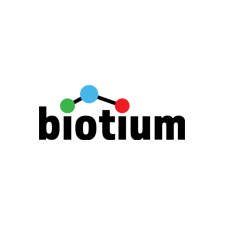DNA Ligase 1(1A9), 0.2mg/mL
Cat# BNUB2177-100
Size : 100uL
Brand : Biotium
| Antibody number | #2177 |
|---|---|
| Antibody reactivity (target) | DNA Ligase 1 |
| Antibody type | Primary |
| Host species | Mouse |
| Clonality | Monoclonal |
| Clone | 1A9 |
| Isotype | IgG1, kappa |
| Molecular weight | 133 kDa |
| Synonyms | DNA ligase 1; DNA ligase I; DNLI1_HUMAN; LIG 1; lig1; Ligase I DNA ATP dependent; MGC117397; MGC130025; Polydeoxyribonucleotide synthase [ATP] 1 |
| Human gene symbol | LIG1 |
| Entrez gene ID | 3978 |
| SwissProt | P18858 |
| Unigene | 1770 |
| Immunogen | Full-length native cow LIG1 protein |
| Antibody target cellular localization | Nucleus |
| Species reactivity | Bovine, Human, Mouse, Rat |
| Expected antibody applications | Flow, surface (published for clone), Functional studies (published for clone), IP (published for clone) |
| Antibody application notes | Western blot 0.5-1 ug/mL; ELISA; Immunoprecipitation; Optimal dilution for a specific application should be determined. |
| Positive control | MOLT-4, PC-3 or Jurkat cell lysates. |
| Shipping condition | Room temperature |
| Storage Conditions | Store at 2 to 8 °C, Protect fluorescent conjugates from light, Note: store BSA-free antibodies at -10 to -35 °C |
| Regulatory status | For research use only (RUO) |
| Antibody/conjugate formulation | Conjugates: 0.1 mg/mL in PBS/0.1% BSA/0.05% azide, HRP conjugates: 0.1 mg/mL in PBS/0.05% BSA, Purified: 0.2 mg/mL in PBS/0.05% BSA/0.05% azide, Purified, BSA-free: 1 mg/mL in PBS without azide |
| Shelf life | Guaranteed for at least 24 months from date of receipt when stored as recommended |
| Product origin | Product may contain either bovine serum albumin (BSA) from bovine serum (Bos taurus), or recombinant BSA produced in Chinese hamster ovary cells. Inquire for the specific lot. |
Product Description
DNA Ligase I maintains the major DNA Ligase activity in proliferating cells by joining Okazaki fragments during lagging strand DNA replication. Human DNA Ligase I also has an essential role in DNA repair pathways, where it catalyzes the formation of phosphodiester bonds between adjacent 5′ phosphoryl and 3′ hydroxy termini at single breaks in duplex DNA molecules. In addition, DNA Ligase I plays a role in sealing nicks during excision repair. Similar to other DNA ligases, DNA Ligase I is built around a common catalytic core. Increased levels of DNA Ligase I are found in human tumors, as compared to benign tissues, as well as in peripheral blood lymphocytes. DNA Ligase I activity is altered in the chromosomal breakage deficit Bloom’s syndrome (BS). Individuals with BS either have decreased levels of abnormally thermolabile DNA Ligase I or possess a dimeric form of this enzyme.
Primary antibodies are available purified, or with a selection of fluorescent CF® dyes and other labels. CF® dyes offer exceptional brightness and photostability. See the
CF® Dye Brochure
for more information. Note: Conjugates of blue fluorescent dyes like CF®405S and CF®405M are not recommended for detecting low abundance targets, because blue dyes have lower fluorescence and can give higher non-specific background than other dye colors.info@biovalley.fr
to inquire about stock status and lead times before placing your order.Catalog number key for antibody number 2177, Anti-DNA Ligase 1 (1A9)
| Antibody # prefix | Conjugation | Ex/Em (nm) | Laser line | Detection channel | Dye Features |
|---|---|---|---|---|---|
| BNC04 | CF®405S | 404/431 | 405 | DAPI (microscopy), AF405 | CF®405S Features |
| BNC88 | CF®488A | 490/515 | 488 | GFP, FITC | CF®488A Features |
| BNC68 | CF®568 | 562/583 | 532, 561 | RFP, TRITC | CF®568 Features |
| BNC94 | CF®594 | 593/614 | 561 | Texas Red® | CF®594 Features |
| BNC40 | CF®640R | 642/662 | 633-640 | Cy®5 | CF®640R Features |
| BNC47 | CF®647 | 650/665 | 633-640 | Cy®5 | CF®647 Features |
| BNC74 | CF®740 | 742/767 | 633-685 | 775/50 | CF®740 Features |
| BNCB | Biotin | N/A | N/A | N/A | |
| BNUB | Purified | N/A | N/A | N/A | |
| BNUM | Purified, BSA-free | N/A | N/A | N/A |
References
Note: References for this clone sold by other suppliers may be listed for expected applications.
- PNAS USA (1987) 84:1374-1378. (Flow, IP)
- Eur J Immunol (1990) 20: 509-515. (functional studies)
- J Immunol (2003) 171:2496-2503. (Flow; IP; functional studies)




